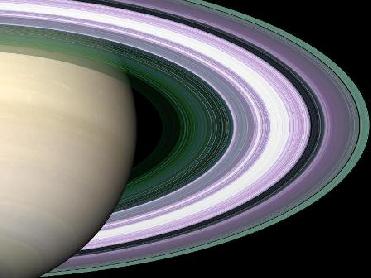
In this simulated image of Saturn's rings, color is used to present information about ring particle sizes in different regions based on the measured effects of three radio signals. Image Credit: NASA
Saturn is the second largest planet. Only Jupiter is larger. Saturn has seven thin, flat rings around it. The rings consist of numerous narrow ringlets, which are made up of ice particles that travel around the planet. The gleaming rings make Saturn one of the most beautiful objects in the solar system.
The rings of Saturn surround the planet at its equator. They do not touch Saturn. As Saturn orbits the sun, the rings always tilt at the same angle as the equator.
The seven rings of Saturn consist of thousands of narrow ringlets. The ringlets are made up of billions of pieces of ice. These pieces range from ice particles that are the size of dust to chunks of ice that measure more than 10 feet (3 meters) in diameter.
Saturn's major rings are extremely wide. The outermost ring, for example, may measure as much as 180,000 miles (300,000 kilometers) across. However, the rings of Saturn are so thin that they cannot be seen when they are in direct line with Earth. They vary in thickness from about 660 to 9,800 feet (200 to 3,000 meters). A space separates the rings from one another. Each of these gaps is about 2,000 miles (3,200 kilometers) or more in width. However, some of the gaps between the major rings contain ringlets.
The Saturn's rings have fascinated scientists ever since Italian astronomer Galileo Galilei first spotted them through one of his telescopes in the 17th century. Detailed study by the Voyager 1 and Voyager 2 spacecraft in the 1980s only increased the mystery.
While the other three gas planets in the solar system - Jupiter, Uranus and Neptune - have rings orbiting around them, Saturn's are by far the largest and most spectacular. With a thickness of about 1 kilometer (3,200 feet) or less, they span up to 282,000 km (175,000 miles), about three quarters of the distance between the Earth and its moon.
On June 30, 2004, the Cassini spacecraft entered orbit around Saturn to begin the first in-depth, up-close study of the ringed planet and its domain. As expected, the Saturn System has provided an incredible wealth of opportunities for exploration and discovery.
The Cassini spacecraft captured many exquisite natural color views of the rings from its vantage point beneath the ring plane with the narrow angle camera. Color variations in Saturn's rings have previously been seen in Voyager and Hubble Space Telescope images. Cassini images show that color variations in the rings are more distinct in this viewing geometry than they are when seen from Earth. Cassini also unraveled that Saturn's rings are made primarily of water ice. Since pure water ice is white, it is believed that different colors in the rings reflect different amounts of contamination by other materials, such as rock or carbon compounds. � Courtesy: NASA
 Previous Article
Previous Article Next Article
Next Article













The Indian Air Force, in its flight trials evaluation report submitted before the Defence Ministry l..
view articleAn insight into the Medium Multi-Role Combat Aircraft competition...
view articleSky enthusiasts can now spot the International Space Station (ISS) commanded by Indian-American astr..
view article